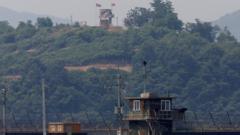Did South Korea Just Fire Warning Shots at North Korean Troops?

South Korea's recent firing of warning shots at North Korean soldiers has escalated tensions along the heavily fortified border, amid ongoing hostilities and efforts towards reconciliation. This incident highlights the fragile state of inter-Korean relations, with North Korea accusing South Korea of provocations and risking uncontrolled conflict.
Last updated: 09 October 2023 (BST)
Key Takeaways
- Warning shots were fired by South Korea after North Korean soldiers briefly crossed the military demarcation line.
- North Korea termed the incident a "deliberate provocation," raising concerns over escalating tensions.
- The confrontation coincides with new South Korean President Lee Jae Myung’s diplomatic visit to Tokyo and Washington.
- Efforts for reconciliation between the two Koreas have stalled, despite Lee's election campaign promises.
- The Korean Peninsula remains technically at war, as no peace treaty was signed after the Korean War in 1953.
The Incident and Its Context
On Tuesday, 3 October 2023, South Korea's Joint Chiefs of Staff (JCS) reported that North Korean troops crossed the military demarcation line (MDL) around 15:00 local time in Seoul (07:00 BST). In response, South Korea fired more than ten warning shots using a machine gun, as confirmed by North Korean Army Lt Gen Ko Jong Chol. Following the incident, the North Korean soldiers quickly returned over the line. This brief incursion has heightened fears of potential conflict in an already tense region.
North Korean Response
North Korean state media reacted strongly to the incident, labelling the actions of the South Korean military as a "serious prelude" that could lead to uncontrollable tensions. They accused South Korea of escalating the situation, highlighting a pattern of hostility that has characterised inter-Korean relations for decades. Pyongyang views such military actions as aggressive provocations and has often responded with threats of retaliation.
Diplomatic Tensions and Recent Developments
The recent flare-up in tensions coincides with a significant diplomatic moment for South Korea, as President Lee Jae Myung embarked on a visit to Tokyo and Washington. Lee, who campaigned on improving relations with North Korea, faces a challenging environment wherein his overtures for dialogue have been met with resistance from Pyongyang. Kim Yo Jong, sister of North Korean leader Kim Jong Un, has openly dismissed Seoul's attempts at reconciliation, suggesting a hardening stance from the North.
Historical Context of the Korean Divide
The Korean Peninsula has been divided since the end of the Korean War in 1953, which concluded with an armistice rather than a peace treaty. This means that both North and South Korea remain in a state of war, with the Demilitarised Zone (DMZ) serving as a buffer between the two nations. The DMZ is not a barbed wire barrier; rather, it is a strip of no-man's land that is often obscured by dense vegetation, contributing to frequent military incidents. Over the years, the DMZ has seen various confrontations, although it has been relatively quiet in recent years.
Military Operations and Propaganda
In a bid to restore trust between the two Koreas, South Korea had previously suspended its loudspeaker propaganda broadcasts aimed at the North. These broadcasts have long been a source of contention, with North Korea perceiving them as acts of war. The cessation of such broadcasts was part of a broader strategy to ease tensions, yet the recent warning shots indicate a return to a more confrontational military posture.
Implications for Future Relations
The ongoing military posturing and inflammatory rhetoric from both sides suggest that the path to reconciliation remains fraught with obstacles. The military exchanges not only reflect the fragile nature of peace on the Korean Peninsula but also underscore the complexities of inter-Korean diplomacy. The international community watches closely, aware that miscalculations could lead to broader conflicts.
What Comes Next?
The situation remains dynamic, with both North and South Korea likely reassessing their military strategies and diplomatic approaches. President Lee's visit to Tokyo and Washington may yield support for increased pressure on North Korea, but it also risks further alienating Pyongyang. As the geopolitical landscape evolves, both nations must navigate their next steps with caution to avoid missteps that could escalate tensions further.
Conclusion
The firing of warning shots by South Korea has once again highlighted the precarious nature of relations on the Korean Peninsula. With North Korea viewing these actions as provocations, the cycle of hostility appears set to continue unless significant diplomatic breakthroughs occur. The international community remains vigilant, recognising the potential for conflict that permeates this divided region.
FAQs
What prompted South Korea to fire warning shots at North Korean soldiers?
South Korea fired warning shots after North Korean soldiers briefly crossed the military demarcation line on 3 October 2023, leading to heightened tensions between the two nations.
How did North Korea react to the warning shots fired by South Korea?
North Korea condemned the warning shots as a "deliberate provocation," warning that such actions could escalate tensions further along the border.
What is the significance of the Demilitarised Zone (DMZ)?
The DMZ is a buffer zone separating North and South Korea, established after the Korean War. It is a highly militarised area that has historically been a flashpoint for conflict.
What efforts have been made towards reconciliation between North and South Korea?
Efforts towards reconciliation have included South Korea suspending propaganda broadcasts and diplomatic outreach by President Lee Jae Myung. However, these efforts have met resistance from North Korea.
Why is the Korean Peninsula still technically at war?
The Korean War ended in 1953 with an armistice, not a peace treaty, meaning that North and South Korea remain technically at war, with ongoing military tensions.
As the situation on the Korean Peninsula evolves, the need for careful diplomacy and communication remains crucial to prevent further escalations. How will the latest developments shape the future of inter-Korean relations? #KoreaTensions #Diplomacy #Geopolitics
Published: 2025-08-23 07:45:09 | Category: world



